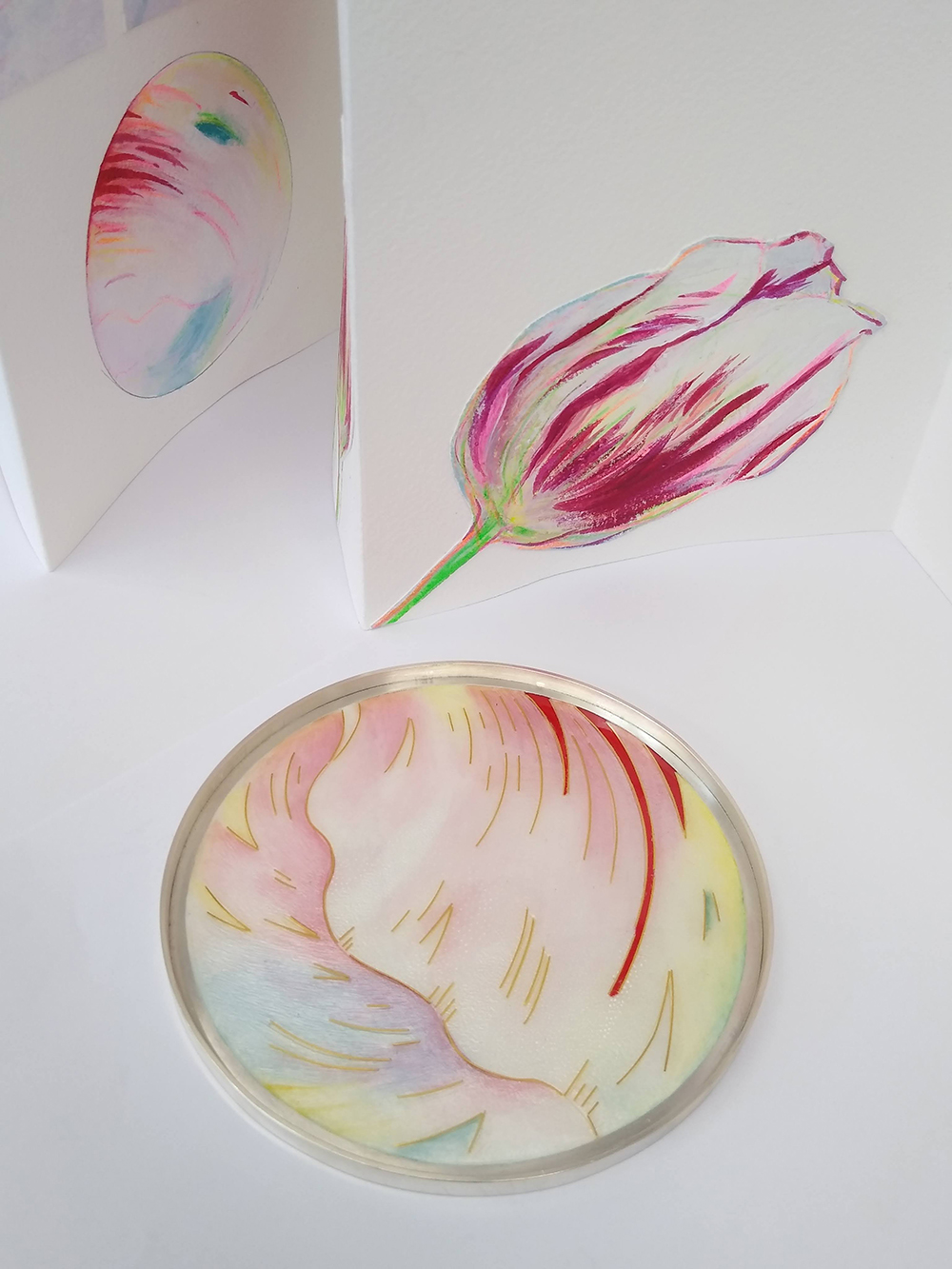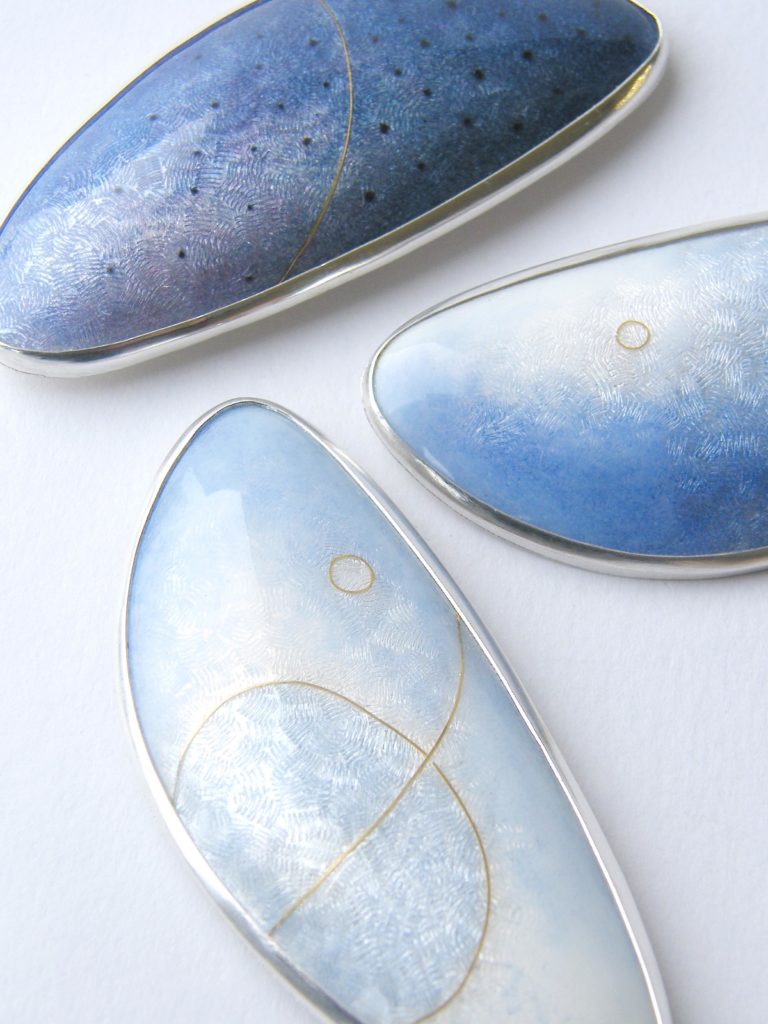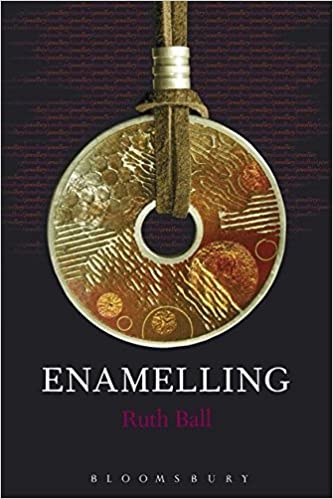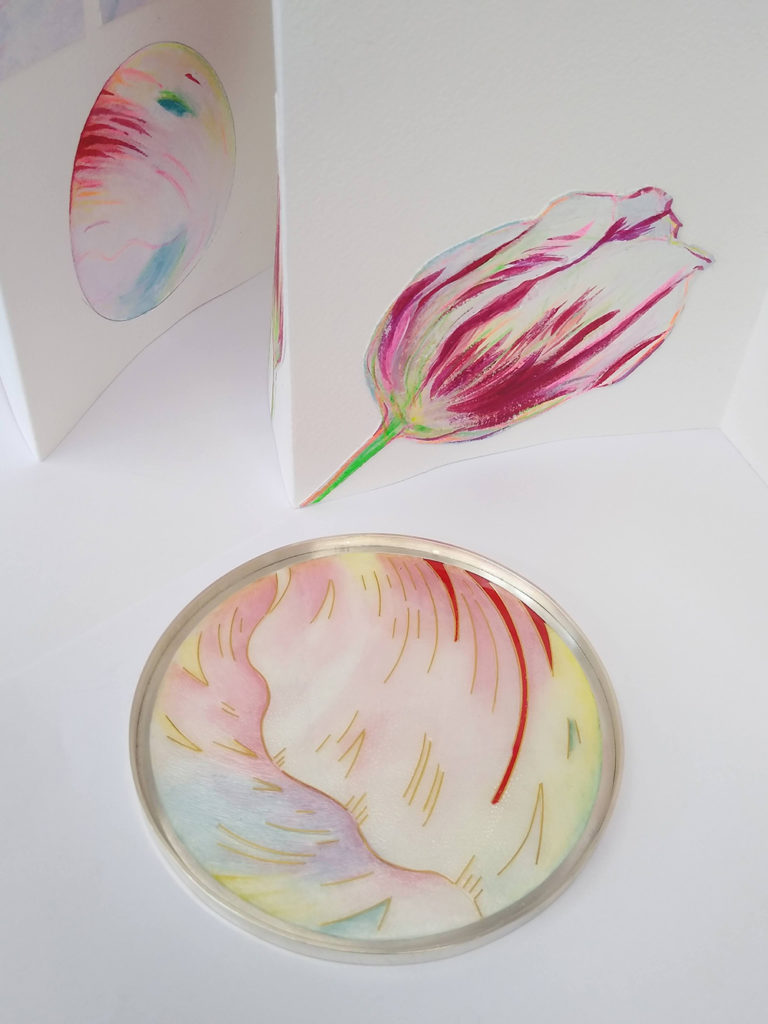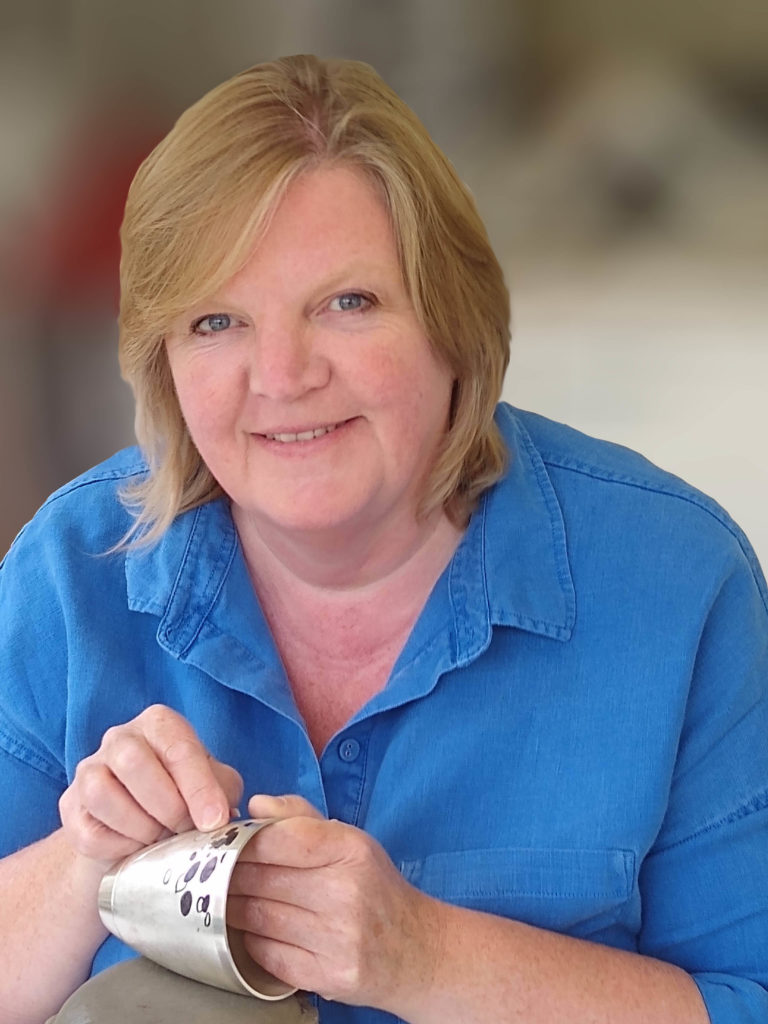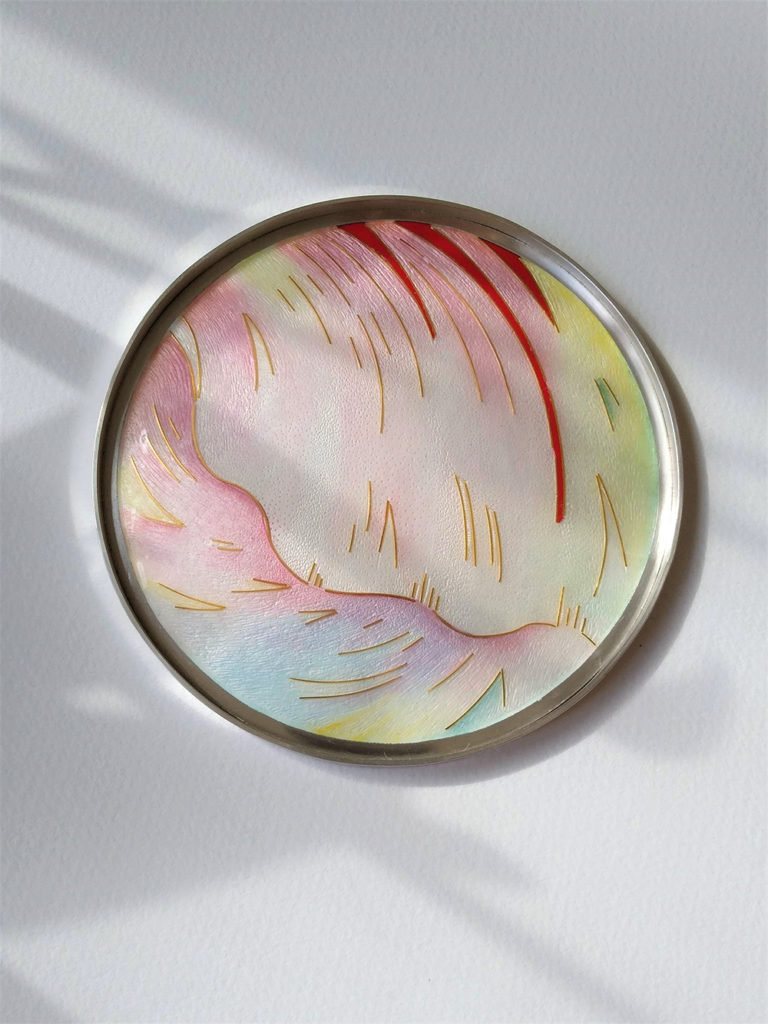Please describe your work:
The extent of my making spans contemporary jewellery, fine silverware and unique artworks for public or private display. I have an art based, painterly approach to enamelling and the observation of colour and light in everyday environments sustains my modern design style.
What are your inspirations?
Predominantly, and intuitively it is colour that charges my interest. The observation of the effects of light and shadow are a main attraction. I enjoy an interest in drawing and mark making so I am equally influenced by a wide range of painters and illustrative work. I am currently also on a year long printmaking course. It sounds a lot but I am enjoying the challenge of new ideas. I am influenced at the moment by the work of artists like Robert Rauschenberg. I constantly aspire to create a contemporary aesthetic based on a wide range of sources. My sketch books are a busy mix of abstract collages photographs and quickly drawn sketches.
What are you working on now?
I tend to work on several things at a time. In between teaching, my week varies from enamelling trade pieces to working on commissions. At the moment in my own work, I am focusing on recording the tulips I plant in tubs in the garden. Each year I try to find different varieties. The intention is always to sketch them but mostly I rely on photographing them as life often gets too busy.
It seems nature is a real inspiration, how does this effect your work in cloisonné.
I hadn’t thought about it, but yes, nature is a big theme when I look at my work. Cloisonné has a big history of nature as the element of the design. However, I tend to see things mostly as illustrating, so Cloisonné is the translation of the sketches I do rather than a formal partition of the image. I like to use a more free approach, using round wires rather than the traditional rectangular. Using round wire allows me to use the line as a drawn element.
What is your background and training?
I have a BA Hons degree in Jewellery Design from Middlesex University, London. While at school, recieved top prizes in the Royal Society of Arts Award and The Platinum Competition. In 2009 I was granted a British Society of Enamellers Bursary to study large scale enamelling and achieved Commended in the Goldsmiths Craftsmanship and Design Council Awards in 2011.
I was a part time lecturer in Further & Higher Education, an this was coupled with years of working in trade enamelling, this meant that I have a wide skill base. Well and many of you may know about my book “Enamelling” published by A&C Black about enamel techniques. I feel very lucky to now be recognized internationally for variety of enamel methods.
What has lead you to do the work you do.
I think my work is mostly lead by the emphasis on a fine art approach to making jewellery that was fostered at Middlesex University. The course was a wonderful mix of learning traditional techniques but taught not just by amazing enamellers but also jewellers like Caroline Broadhead and Pierre Dean. There was an emphasis on experimenting with materials and learning through making. The ethos was to be innovative.
After college I also went on short courses with enamellers such as Elizabeth Turrell and got to know many enamellers through the British Society of Enamellers and the Guild of Enamellers. Attending their conferences opened up a wide range of techniques and enamellers practices. This carries through with me today. I was also taught classically in fine enamelling on my placement with Alan Mudd and Keith Seldon so I feel that I have been blessed with understanding many approaches.
Tell us about your process and how you came to work this way.
I use a variety of methods. The main three techniques in my work are Champleve where I pay attention to the surface of the metal, Cloisonné in which I draw with the wires and Painted enamel which can become part of either technique. Often I use all three methods in the one piece. In my trade work I can also use painted enamel exclusively to create a miniature. Working form ideas in sketchbooks dominates. Having a strong knowledge of the basics enables me to experiment and push ideas when I want to. I still feel like I am learning. Enamel is a fascinating material that has the capacity to have so many effects. I also learn through teaching, in each class there is an opportunity to discover something.
Has your practice changed much over time?
I have just developed different designs and moved into different techniques though working on the variety of commissions that I have completed. The most interesting dynamic is moving from making jewellery to scaling ideas up to be able to offer designs in silver and producing enamel pieces for public art work. I feel like I wear different hats but the materials are the same.
Do you experiment a lot or do you work within a specific set of parameters?
I do experiment. Often the “playing” with ideas starts on paper though experimenting with the image itself. The process follows through with the enamel to create a piece that is hopefully new and exciting.
Describe your teaching style. What is the most exciting part of teaching for you?
I like to think that my teaching style is approachable and informal. In online sessions I lead with demonstrations and slide shows but I like building the lessons around a Question and Answer format so that students get chance to check things through to understand the processes.
The most exciting part of the teaching for me is seeing how students develop their own work. Its always incredible to see each participants own signature style come through within their samples.
Who are your favorite artists/enamelists? (what are your most important influences)
I have a great respect for the enamel work of my University Tutors, Alan Mudd, Keith Seldon, Jane Short and Ros Conway. I was incredibly lucky to have their influence at an early stage. I also greatly admire the work of Fred Rich, Elizabth Turrell, Jamie Bennet, William Harper and Sarah Perkins, the list goes on. The thing that stands out to me is that enamel can carry such a deeply individual visual language. Each artist translates their personal voice through their work with the same materials but to very different effect.
Do you have a dream project that you’ve always wanted to do?
There are several projects that I have on my agenda. I dream a lot ! As mentioned I am keen on creating sketch books so there are more ideas than time generally. There are two thoughts in particular that I am considering. I am working towards creating box forms and building enamel surfaces in a more three dimensional way. This is a challenge at the moment as I need to gain more silversmithing skills.
The other idea that I work toward is the creation of an installation of abstract brooches. This might involve displaying the painted design work alongside the pieces and exhibiting the work using a fine art approach. Because I want to create a collection it might take me a while to build in terms of time. Both ideas are still in their embryonic stages so its early days.
Please tell us about the workshop you will be offering at the EGNE conference.
As it is Tulip season I will be working form my photographs and drawings of tulips. I will talk about the qualities of line and mark making and discuss my free-form approach to cloisonné and foil application. I think of cloisonné as drawing with wire and applying foils as making marks. Linking the tulip images to the demonstration I will create a section of a drawing as a sample piece. I am very fond of variegated tulips, the petals with broken colours that were very popular in the Dutch golden era are still really attractive and hard to find. They lend themselves to a creative approach and a fluid way of working.

